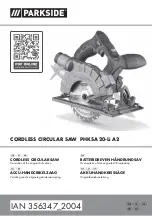
DESCRIPTION
1. Tension knob
2. Blade tension lever
3. Tracking knob
4. Wheel locking blade guide
5. Knob for adjusting the inclination of the table
6. Table tilt locking knob
7. Dust extraction nozzle
8. Rubbet feet
9. Additional support
10. Control wheel upper blade guide
11. Rip fence
12. Working table
13. On/off switch
14. Upper blade guard
15. Blade
16. Table support assembly
17. Lower blade guide
18. Drive belt
19. Lower wheel
20. Door
21. Upper wheel
22. Motor assembly
23. Upper viewing port
SPECIFICATIONS
Voltage:
Speed:
Blade length:
Blade width:
Table size:
Max. cutting depth:
Max. cutting width:
Net weight:
UNPACKING
Carefully unpack the band saw and all of its parts, and
compare them against the list below. Do not discard the
carton or any packaging until the band saw is completely
assembled.
WARNING:
If any part is missing or damaged, do not
plug the band saw in until the missing or damaged part is
replaced.
ASSEMBLY
WARNING:
Before assembling the band saw, remove the
safety key and unplug the power cord from the electrical
outlet. The power cord must remain unplugged whenever
you are working on your band saw.
RUBBER FEET MOUNTING (Fig.1)
Before cutting, assemble the four rubber feet to holes in the
four corner of base with bolts (M6*30), big flat
washers 6,
and nuts (M6) as show in picture.
MOUNTING THE ADDITIONAL SUPPORT (Fig.2)
●
Insert the additional support into the corresponding two
holes in the side of base.
●
Align the holes in the supporting and the surface of base.
●
Secure the supporting with two bolts and nuts.
MOUNTING THE WORKING TABLE (Fig.3-5)
●
Remove the bolt and wing nut from the hole located in
the front edge of table.
- 6 -
●
Carefully slide the table over the blade, through the slot
in the table.
●
Remove knob assembly from saw frame.
●
Position table assembly on saw frame. Re-install knob
assembly.
●
Secure table in position with locking handle assembly.
●
Using a combination square, set table perpendicular to
blade. Adjust table stop if necessary.
●
Set pointer at 00. - Insert and tighten the bolt and wing
nut into the hole located in the front edge of the table.
INSTALL THE FENCE (Fig.6)
●
Raise the clamp on the fence assembly to the up
position.
●
Place the fence on the table so that the clamp is at the
front of the table.
●
Lower the fence clamp in order to lock the fence in
position on the table.
●
To move the fence, raise the clamp and slide the fence to
the desired location. Lower the clamp in order to lock the
fence in position.
WARNIGN:
Never use miter gauge and rip fence at the
same time. The blade might bind in the workpiece. Operator
could be injured and/or workpiece could be damaged.
ADJUSTMENTS
WARNING:
Before adjusting the band saw, turn the
saw off, remove the safety key, and unplug the
power cord from the electrical outlet.
TABLE TILT ADJUSTMENT (Fig.7)
●
The table tilts from 0° to 45° to the right.
●
Turn the table tilt lock lever counterclockwise.
●
Turn the table tilt adjustment knob until the pointer is at
the desired angle on the table tilt gauge.
●
Tighten the table lock lever in order to secure the table.
CONNECT TO A DUST COLLECTION SYSTEM (Fig.8)
A dust port is located on the motor side of the band
saw. This port can be connected directly to a dust
collection system by connecting the pickup end of
the dust collection hose to the dust port.
OPERATION
CAUTION:
Always observe the following safety precaution:
●
Make sure that blade guides and thrust bearing are
positioned and adjusted correctly to prevent sideways
and rearward movement of the blade. Adjust upper guide
to just clear workpiece.
●
Check to make sure blade is tensioned and tracking
properly. Do not over tension the blade in order to under
tensioning to eliminate back and forth, side to side blade
movement as it cuts.
●
Use proper blade for the cutting operation.
●
After turning saw on, allow blade to come to full speed
before attempting any cutting operation.
●
Support workpiece properly and use a smooth steady
feed to guide work through the cut. Use push sticks or
push blocks when required.
●
Keep hands away and out of line with moving parts.
●
Always wear eye protection.
230V ~ 50Hz
11.6m/sec
157.5cm
6.35mm
30 x 30cm
8cm
23cm
18kg
Summary of Contents for BS-230
Page 1: ...BS 230 ...
Page 3: ... 2 Rubber Feet Additional Support Bolt 1 2 Wing Nut 3 4 6 Fence Clamp 5 6 ...
Page 5: ... 4 Miter gauge 13 ...
Page 12: ... 11 ...






























